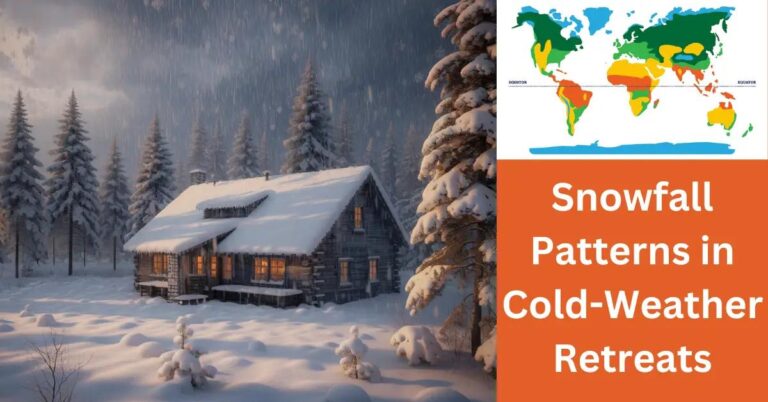TL;DR:
- Temperature Changes: Altitude affects temperature, dropping about 3.5°F per 1000 feet; it rises in the stratosphere due to ozone absorption.
- Weather & Ecosystems: Higher altitudes lead to unique climates, more precipitation, and different ecosystems due to cooler, wetter conditions.
- Atmospheric Pressure: As altitude increases, pressure and air density decrease, impacting local weather patterns and creating microclimates.
- Rainfall & Snowmelt: Mountains affect precipitation and snowmelt timing; rain shadows result from air cooling and warming as it crosses peaks.
- Wind Speed & Forecasting: Wind speeds increase with altitude; forecasting mountainous weather is challenging but vital for safety.
- Practical Implications: Altitude impacts climate zones; understanding this aids in resource management and safety for hikers and planners.
Have you ever wondered how altitude shapes your weather experience? It's a vital piece of the climate puzzle affecting your new home abroad. Let's break it down: As altitude rises, temperature drops, but there's more to it. From average temperature shifts to unique stratosphere quirks, altitude impacts local and global climate. Dive in with me to discover how elevation influences everything from rainfall patterns to wind speed, shaping the climate you live in.
The Impact of Altitude on Weather: What's the Connection?
How does altitude affect weather? Altitude impacts weather by changing temperature and climate. As you go higher, the temperature drops. On average, you lose about 3.5°F every 1000 feet you climb. This change influences how warm or cold a place feels. The higher you go, the cooler it gets, affecting both local and global climate patterns.
But did you know this pattern flips in the stratosphere? Here, temperature may rise with height. This happens because the stratosphere holds the ozone layer. The ozone absorbs sun rays, warming the air around it. This creates an exception to the usual rule of temperature drop.
How does elevation affect temperature? Elevation impacts temperature through thinning air. Thin air holds less heat, which cools the surroundings. This change shifts climate zones, influencing local weather and ecosystems. In mountainous regions, these shifts create unique climates.
How many degrees do you lose per 1000 feet? Most people lose about 3.5 degrees Fahrenheit with each 1000 feet rise. Weather varies widely because of these shifts. For every climb, plants, animals, and weather need to adapt.
Understanding altitude's influence on climate change helps predict future patterns. It is crucial for farmers, city planners, and scientists. They look at how these changes might impact heat, rain, or snow in a region. With this knowledge, we can better plan for the future and manage Earth's precious resources.
The Impact of Altitude on Weather: What's the Connection?
Mountains play a big role in changing how rain falls. When air hits a mountain, it goes up, cools down, and forms clouds. This often leads to mountain-induced precipitation on the side facing the wind. Once the air crosses over, it gets dry and warm quickly, creating a rain shadow effect on the opposite side.
Rainfall varies a lot between different altitudes. Generally, at higher spots, more rain or snow falls. The air holds less water as it cools, so it condenses and falls. Where you are on a mountain can mean more or less rain.
Altitude greatly influences local ecosystems and vegetation. High-altitude areas might have shorter trees or grass due to cooler and wetter weather conditions. Plants help hold soil and keep lands green, showing how dependent they are on weather patterns linked to elevation.
Water availability and snowmelt timing are also altered by altitude. At greater heights, snow tends to melt later in the year because temperatures stay cooler longer. It means rivers in the valleys might get water later in spring or summer.
Understanding the role of altitude helps predict how mountains interact with weather, plants, and water. Knowing these patterns aids in planning for resource management in mountainous areas. This knowledge becomes key for farmers, builders, and conservationists managing climate impacts at different altitudes.
Impact of Altitude on Atmospheric Pressure and Climate
As altitude increases, atmospheric pressure decreases. This means air becomes less dense and holds less heat. Hence, weather patterns can change with altitude.
Think about how air pressure affects weather. High pressure leads to sunny skies, while low pressure can bring rain. As we go up a mountain, the pressure drops. This change influences local weather in different ways.
Altitude not just changes weather patterns; it also reshapes entire climate zones. For example, higher elevations often have cooler and drier climates than lowlands. This is why mountain tops usually have snow, while valleys do not.
Microclimates emerge because of these changes. Each region can have its own unique weather and plants due to how the altitude affects air pressure. These small climate zones can be very diverse. Some may experience frequent rain, while others get lots of sun.
In areas with high altitudes, the atmosphere's layered structure also comes into play. The stratosphere—above the troposphere—actually gets hotter with height. To answer the tough question, "Does the temperature increase or decrease with altitude in the stratosphere?"—it increases.
Understanding these factors helps explain the variety of weather we see. The connection between altitude and weather forms unique climates that impact life and nature in fascinating ways.
The Impact of Altitude on Weather: What's the Connection?
At high altitudes, the weather can change a lot. The higher you go, the colder it gets. For every 1,000 feet you climb, the temperature drops about 5.4 degrees Fahrenheit. So, at 10,000 feet, it's much colder than it is down below.
Wind speed acts differently at various elevations. It can be much stronger high up in the mountains. As you climb, air density gets lower, making it easier for wind to move faster. Wind can scream around mountain peaks and through narrow passes. This wild wind makes climbing tricky and, sometimes, dangerous.
Weather forecasting in mountainous places is a tough job. Mountains create their own weather, and it often changes fast. The local weather can fool forecasters down below. You need special tools and a careful eye to forecast these high-altitude spots. Satellite data and ground-based stations help, but it's still a challenge.
Mountain passes need accurate weather reports to stay open and safe. These areas can be dangerous due to sudden weather changes. To predict weather changes in these places, forecasters rely on Real-time weather technology.
Weather at high altitude affects many lives. Hikers, climbers, and even animals rely on accurate weather forecasts. When you're planning a trip to the mountains, always check the weather. It keeps you safe and helps you prepare for what nature might throw your way. Understanding how high-altitude weather works can save lives and make adventures more enjoyable.
Conclusion
We've explored how altitude changes temperature, precipitation, and weather patterns. For each 1000 feet, temperature usually drops about 3-5 degrees. But in the stratosphere, it sometimes heats up. Mountains shift rain patterns, affecting local plants and water cycles. Air pressure lessens with height, changing weather and creating microclimates. Lastly, high places alter wind speed and pose weather forecasting challenges. Altitude shapes our climate in amazing ways, reminding us of nature's power and complexity. Embrace these insights to better understand the weather in high places.












